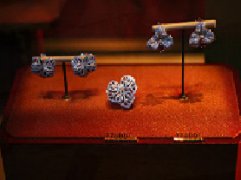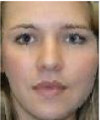Group Mini-Project Topics
|
1. Removal of Reflections in Image
Images captured in front of a semi-transparent glass panel often contain both the
transmitted background scene and the reflection of the objects in front of the glass panel.
Reflections corrupt the contents of the images, making computation of the images difficult.
Objective
Given a set of images of the same background scene with possibly different reflections,
remove the reflections in the images and recover the background scene.
|
|
 |
image with reflection |
|
image without reflection |
Resources
> Sample low-resolution images with reflections: reflection-lowres.zip
> Sample high-resolution images with reflections: reflection-highres.zip (38MB)
|
2. Removal of Occlusions in Face Images
Human faces in images are often occluded by glasses, hats, scarves, masks, veils,
hands, hairs, and other objects. Face occlusions hampers important human activities
such as security, surveillance, identification, forensic investigation, etc.
Objective
Given a set of unoccluded training images and an occluded target image, remove
the occlusion in the target image and recover the facial features under the occlusion.
|
|
 |
image with occlusion |
|
image without occlusion |
Resources
> Google image, with keyword "face".
> FERET database: Colour face images maintained by NIST. Request download through email.
> CMU Multi-PIE database: Buy from CMU (or approach instructor for databse after you have tried FERET database).
|
3. Alignment of Natural Images
Images of the same scene taken at different viewing angles differ in details such as
angles of lines and edges. Before these images can be used in various applications
such as image mosaicking, reflection removal, and background recovery, they have to be
spatially aligned.
Objectives
Given a set of images of the same static scene taken from different viewing angles,
transform them so that they are spatilly aligned.
 |
|
 |
frontal view |
|
oblique view |
Resources
> Google image, with keyword of the same object, e.g., "whitehouse".
|
4. Alignment of Face Images
Image of human faces may be taken at different viewing angles or head poses. Before these images can be used in various applications such as face recognition and face image deocclusion,
they have to be spatially aligned.
Objectives
Given one or more images of human faces, which may or may not belong to the same person, transform them to frontal view.
|
|
 |
oblique view |
|
frontal view |
Resources
> Google image, with keyword of the same person, e.g,. "face obama".
> CMU Multi-PIE database: Buy from CMU (or approach instructor for databse after you have tried Google).
|
5. Reconstruction of Face from Skull
During crime scene investigation, an investigator may discover the skull of a victim
whose face are damaged beyond recognition. To identify the victim, the investigator
needs to first reconstruct the face from the skull as accurately as possible.
Objective
Given a 3D model of a skull, reconstruct the face that fits the skull as accurately as possible. You may use the 3D model of a generic face in the reconstruction.
|
|
 |
skull model |
|
face model |
Notes
Anatomists have studied the relationship between human skull and face in detail
and come up with models of average depth of the face from the skull at various
landmark points. You may use this information in the reconstruction.
References
These papers and books talk about skull landmarks and facial tissue depth. You should be able to get them from NUS Library or its e-resources:
> D. Anderson, L. Anderson, and W. Glanze. Mosby's Medical Dictionary,
10th Ed. Elsevier, 2016.
>
Domaracki, M., & Stephan, C. N. Facial soft tissue thicknesses in Australian adult cadavers. Journal of Forensic
Sciences, 51(1), 5-10, 2006.
> Dong, Y., Huang, L., Feng, Z., Bai, S., Wu, G., & Zhao, Y. Influence of sex and body mass index on facial soft tissue thickness
measurements of the northern chinese adult population. Forensic Science International, 222(1-3), 2012, 396.e1–396.e7.
> George, R. M. Anatomical and artistic guidelines for forensic facial reconstruction. In M. Y. Iscan & R. P. Helmer edited, Forensic
Analysis of the Skull: Craniofacial Analysis, Reconstruction, and Identification, Wiley, 1993, 215-228.
> Greef, S. D., Vandermeulen, D., Claes, P., Suetens, P., & Willems, G. The influence of sex, age and body mass index on facial soft
tissue depths. Forensic Science, Medicine, and Pathology, 5(2), 60 - 65, 2009.
> M. Y. Iscan and R. P. Helmer. Forensic Analysis of the Skull: Craniofacial
Analysis, Reconstruction, and Identification. John Wiley &
Sons, 1993.
> Stephan, C. N., & Simphson, E. K. Facial soft tissue depths in craniofacial identification (Part I): An analytical review of the rublished
adult data. Journal of Forensic Science, 53(6), 2008, 1257-1272.
> Starbuck, J. M., & Ward, R. E. The affect of tissue depth variation on craniofacial reconstructions. Forensic Science International,
172(2), 2007, 130-136.
Resources
> Adam skull and face: adam.zip
> Eve skull and face: eve.zip
> Generic face: face.ply
Note: The 3D models are stored in PLY format, one of the standard 3D mesh file format. You can use MeshLab to view them.
|
6. Camera Colour Calibration
Modern smart phones have pretty high-resolution cameras that are being used in a wide variety of applications.. A difficulty with using smart phone cameras, or more prefessional SLR cameras, is that cameras of different models capture the colours of a scene differently, for example:

To use smart phone cameras in applications that require exact measurement of colours, it is necessary to first calibrate the cameras against a standard reference so that the images captured by these cameras can be colour-normalized.
Objective
Given a reference camera and a target camera, derive the colour matching function that transforms the colours of a scene taken by the target camera to the colours of the same scene taken by the reference camera.
Notes
Colour appearance is affected not only by the camera but also the lighting condition. A standard way to reduce the difference in lighting condition is called white balancing. You may include white balancing as a part of your colour normalization algorithm.
Resources
> Take pictures with various smartphones. |
| |
|
